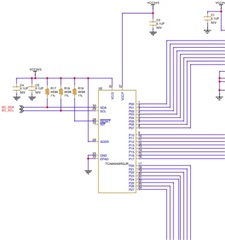Other Parts Discussed in Thread: TCA6424
Hi,
I've designed a board with a TCA6424A, but I've problems to read and write in this component.
The I2C bus connects this TCA6424A and also two TCA6416As and I don't have problems to read and write in the registers of the two TCA6416As.
The idea is that the TCA6424A is in reset status because it doesn't move the ACK also if the access cycle is correct.
Reading the TCA6424A's datasheet I've observed that the Exposed pad must be connected to secondary ground
or float. In my design the Exposed pad is connected to ground. I've noted also that another difference
between the TCA6424 and the TCA6424A datasheets is that in the datasheet of the TCA6424A there is a clear suggestion
about the exposed pad connection while in the TCA6424 no.
Do you think that access problems depend on the Exposed pad connects to ground?
Could you help me to analyze the problem?
Thank in advance.


